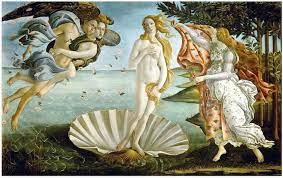Non Western Blog
A Virtual Exhibit of Traditional Japanese - Nonwestern Blog
1. The Great Wave off Kanagawa by Katsushika Hokusai (c.
1830-1833)
The Great Wave off Kanagawa by Katsushika Hokusai (c.
1830-1833), possibly the most famous and iconic ukiyo-e print, is the first
piece on display in this exhibition. This print, which is a part of the
well-known series Thirty-six Views of Mount Fuji by Hokusai, shows a dramatic
picture of a huge wave that is ready to break over three boats with Mount Fuji
in the background (Smith, 2004). The strong blue and white waves, the delicate
boat lines, and the distant silhouette of Mount Fuji all stand in stark
contrast to each other, creating tension and energy that is both visually
spectacular and amazement, inspiring. The Great Wave off Kanagawa by Hokusai is
an eternal work of Japanese art that continues to charm people all over the
world because to his creative use of perspective and color as well as his
ability to portray the strength and beauty of nature.
2. Woman at the Bath by Kitagawa Utamaro (c. 1798)
A famous ukiyo-e artist noted for his bijin-ga (portraits of
lovely ladies), Kitagawa Utamaro (about 1798) created Woman at the Bath, the
second piece in this exhibition. This print shows a young woman beautifully
adjusting her hair after a bath in private time (Davis, 2004). The woman's
attractiveness and the wonderful patterns of her kimono are highlighted by
Utamaro's precise lines and attention to detail, while the soft, muted colors
give a feeling of intimacy and calm. The beauty and charm of ladies in daily
life are expertly captured in this piece, which is a shining example of the
bijin-ga genre.
3. Actors Ichikawa Danjuro VII as Sukeroku and Iwai Hanshiro
IV as Agemaki by Toshusai Sharaku (c. 1794)
The exhibition's last piece is a print with kabuki theater
themes by the secretive Toshusai Sharaku, who only produced art for ten months
between 1794 and 1795. The handsome hero Sukeroku and his wife Agemaki, played
by Ichikawa Danjuro VII and Iwai Hanshiro IV, respectively, are shown in this
special edition caught in a passionate look (Nagata, 1999). With its strong
lines and vibrant colors, Sharaku's dramatic and colorful design brilliantly
reflects the energy and intensity of the kabuki theater. Despite having a short
career, Sharaku's distinctive and emotive portrayals of kabuki actors left a
lasting impression on the world of ukiyo-e.
This online exhibition, which highlights the various skills
of three significant ukiyo-e painters, has given a brief yet thorough glimpse
into the fascinating world of traditional Japanese woodblock prints. These
works are the best examples of the visual brilliance and cultural relevance of
ukiyo-e, ranging from the iconic imagery of Hokusai's The Great Wave off
Kanagawa to the delicate delicateness of Utamaro's Woman at the Bath to the
dramatic intensity of Sharaku's kabuki portraits. I sincerely hope that this
exhibition has increased people's understanding of this fascinating art form
and its continuing influence on the world of art.
References
Davis, J. (2004). Utamaro and the Spectacle of Beauty.
Reaktion Books.
Kobayashi, T. (1997). Ukiyo-e: An Introduction to Japanese
Woodblock Prints. Kodansha International.
Nagata, S. (1999). Sharaku: A Complete Collection. Kodansha
International.
Smith, H. (2004). Hokusai: One Hundred Views of Mount Fuji.
George Braziller.






Hello Cwalch! I thoroughly enjoyed your Virtual Exhibit of Traditional Japanese – Nonwestern Blog, great job! I have seen the first two pieces before but greatly appreciate your analysis because I missed many details from my initial viewing. For instance, The Great Wave Off Kanagawa is such a striking piece. The waves are mighty and fierce, yet beautiful. They appear to be moving. I had no idea that was Mount Fuji in the background, nor did I know this was part of a series. I also have not noticed the boats before either. A great piece to have for this blog! I wish you would have defined what exactly ukiyo-e art is…I gathered it is a form of traditional Japanese woodblock prints, but I still wonder what it is. I love the colors of your third piece, Actors Ichikawa Danjuro VII as Sukeroku and Iwai Hanshiro IV as Agemaki. Beautiful color palette and the curved lines of the bodies creates movement to this piece.
ReplyDeleteCarli,
ReplyDeleteI found two paintings from your Japanese exhibit to be appealing. I found the "Woman at the Bath" by Kitagawa Utamaro painting to be dull and boring. I didn't find it to be attractive. However, I really liked your choice of the "The Great Wave of Kanagawa" to be refreshing. This painting makes one feel the gravity of the sea from a distance, in my opinion. The colors utilized in this painting are spectacular, and create a beautiful setting for all to see. The size of the waves gives a real-life experience to the observer of the painting. The differences between the selections within this exhibit highlight the diversity within the world of Japanese art.
Abdurahman
Hi Carli, you made an excellent post. I especially liked your choice of "The Great Wave off Kanagawa" with the texture and shape presenting a feeling of it being the moment before disaster strikes the boats. your other two choices of art pieces also represent how people were painted at the time, especially with the trend of elongated faces and slit eyes in the second artwork and colorfully patterned clothing in the third.
ReplyDelete